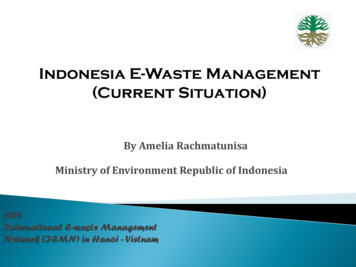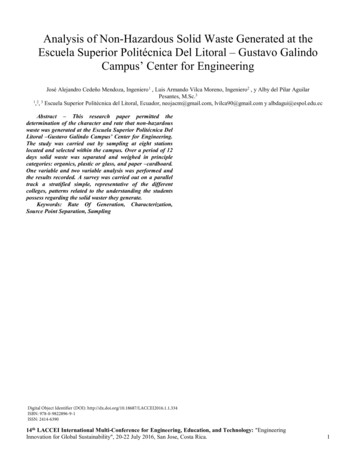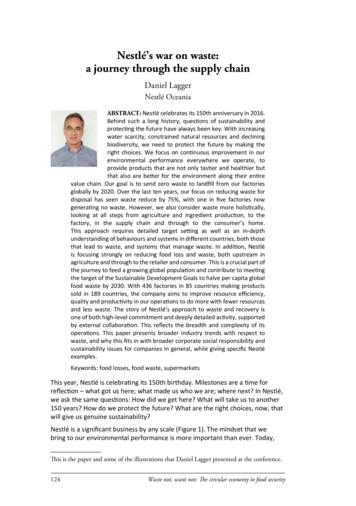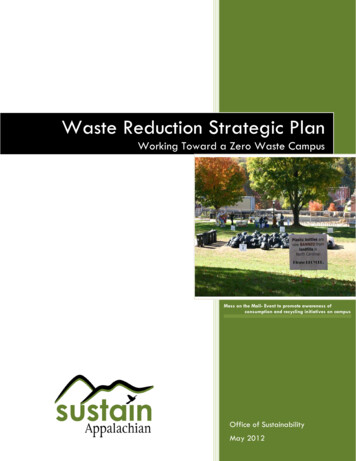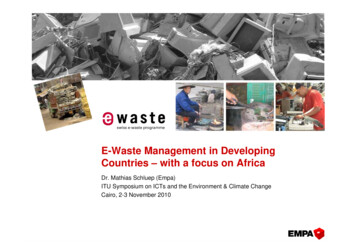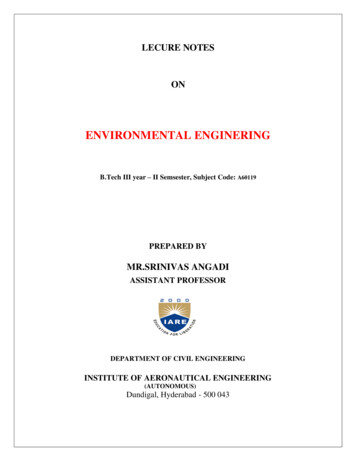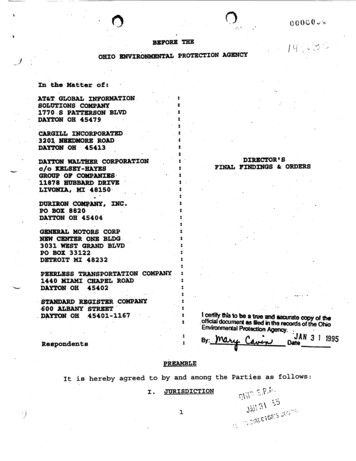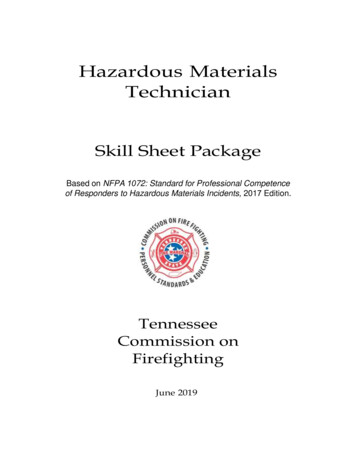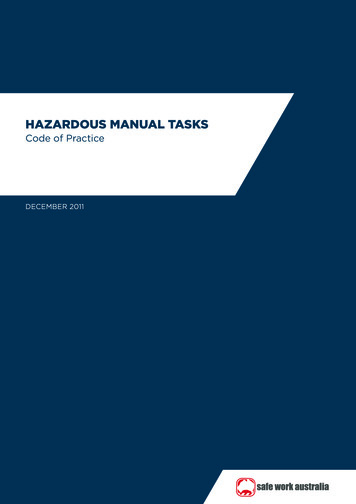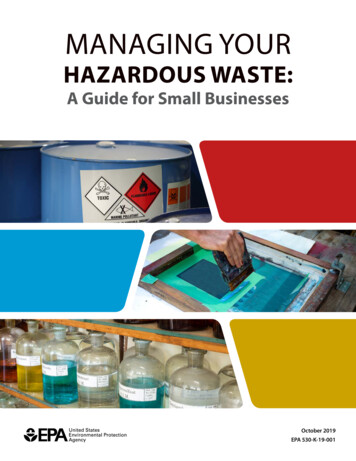
Transcription
MANAGING YOURHAZARDOUS WASTE:A Guide for Small BusinessesOctober 2019EPA 530-K-19-001
TABLE OF CONTENTSINTRODUCTION1DECIDING WHETHER HAZARDOUS WASTE REGULATIONS APPLY TO YOU2Defining Hazardous Waste2Finding Your Generator Category3WHAT HAZARDOUS WASTE DO YOU COUNT TO DETERMINE YOUR GENERATOR CATEGORY?5DO Count5DO NOT Count5UNIVERSAL WASTES AND USED OIL6Universal Wastes6Used Oil6Storage7Oil Leaks or Spills7SUMMARY OF REQUIREMENTS FOR VERY SMALL QUANTITY GENERATORSSUMMARY OF REQUIREMENTS FOR SMALL QUANTITY GENERATORS810Obtaining an EPA Identification Number10Managing Hazardous Waste On Site13Accumulating Your Waste13Treating Your Waste to Meet the Land Disposal Restrictions13Preventing Accidents13Responding to Emergencies15Shipping Waste Off Site17Choosing a Treatment, Storage, and Disposal Facility17Preparing Waste Shipments17Preparing Hazardous Waste Manifests18Land Disposal Restriction Reporting Requirements18Export Notification18Closure18SUMMARY OF REQUIREMENTS FOR LARGE QUANTITY GENERATORS20WHERE TO GET MORE HELP21EPA and Other Federal Resource Centers22EPA Regional Offices23ABBREVIATIONS AND DEFINITIONS25iii
iv
INTRODUCTIONDoes your business generate hazardous waste? Many smallbusinesses do. If you need help understanding which federalhazardous waste management regulations apply to yourbusiness, this handbook is for you. It has been preparedby the U.S. Environmental Protection Agency (EPA) to helpsmall-business owners and operators understand howbest to comply with federal hazardous waste managementregulations.Words or phrases that appear in bold red textthroughout this guide are defined in the “Abbreviationsand Definitions” section, starting on page 25.Each category of generator must comply with the hazardouswaste rules specific to that category. This handbook isintended primarily to help SQGs and VSQGs (that is, businesses that generate a small quantity of hazardous waste)learn about regulations that apply to them.This handbook explains only the federal requirements forhazardous waste management. Many implementingagencies (e.g., states) have their own hazardous wasteregulations based on the federal hazardous waste regulations.Some use the federal requirements and definitions; othershave developed more stringent requirements. If the latteris true for your implementing agency, you must complywith those more stringent regulations. To become familiarwith your local requirements, consult your implementinghazardous waste agency. For the address or phonenumber for your implementing agency, visit grams-and-us-stateenvironmental-agencies.This handbook provides an overview of the regulations togive you a basic understanding of your responsibilities whengenerating and managing hazardous waste. It should not beused as a substitute for the actual requirements. All of thefederal hazardous waste regulations are located in Title 40 ofthe Code of Federal Regulations (CFR), Parts 260 to 299(www.ecfr.gov).EPA defines three categories of hazardous waste generatorsbased upon the quantity of hazardous waste they generateper month:1.Very small quantity generators (VSQGs), whichgenerate less than 100 kilograms (kg) or 220 pounds(lbs) per month.2.Small quantity generators (SQGs), which generatebetween 100 and 1,000 kg (220 and 2,200 lbs) permonth.3.Large quantity generators (LQGs), which generatemore than 1,000 kg (2,200 lbs) per month.Some generators hire a waste management company toaddress all hazardous waste management obligations.Remember, even if working with an outside firm, you areultimately responsible for the proper management of yourhazardous waste throughout its life cycle from cradle tograve.HAZARDOUS WASTE GENERATOR IMPROVEMENTS RULEOn November 28, 2016, EPA finalized a wide-ranging revision of the hazardous waste generator regulations, called theHazardous Waste Generator Improvements Rule. This final rule added flexible standards for episodic generation andconsolidation of waste from VSQGs at LQGs, discussed on pages 3 and 9 of this handbook. The final rule also made otherchanges throughout the hazardous waste generator regulations, revising standards for hazardous waste determinations,marking and labeling of hazardous waste units, emergency planning and preparedness, and closure, among others. Someof these revised standards are mandatory for states to adopt, as they are more stringent than previous regulations. For moreinformation, see the webpage for the final rule te-generator-improvements) or read the rule itself in the Federal Register at 81 FR 85732.1
DECIDING WHETHER HAZARDOUSWASTE REGULATIONS APPLY TO YOUlow doses; these are called acute hazardous wastes.Examples of acute hazardous wastes include berylliumpowder and certain discarded pesticides.Federal hazardous waste management regulations applyto most businesses that generate hazardous waste. Todetermine if these regulations apply to your business, youmust first determine if you even generate hazardous waste. Characteristic wastes. If your waste does not appearon one of the hazardous waste lists, it still might beconsidered hazardous if it exhibits one or more of thefollowing characteristics:FIRST STEPS»» I t catches fire under certain conditions. This isknown as an ignitable waste. Examples are paintsand certain degreasers and solvents. D etermine if you generate hazardous waste in thefirst place. C ount the amount of hazardous waste that youproduce per month.»» I t corrodes metals or has a very high or low pH.This is known as a corrosive waste. Examples arerust removers, acid or alkaline cleaning fluids, andbattery acid. D etermine your generator category to learn themanagement requirements that apply to you.»» I t is unstable and explodes or produces toxicfumes, gases, and vapors when mixed with wateror under other conditions such as heat or pressure.This is known as a reactive waste. Examples arecertain cyanides or sulfide-bearing wastes.Defining Hazardous WasteA waste is any solid, liquid, or contained gaseous materialthat is discarded by being disposed of, burned or incinerated, or recycled. (There are some exceptions for recycledmaterials.) It can be the byproduct of a manufacturingprocess or simply a commercial product that you usein your business—such as a cleaning fluid or batteryacid—and that is being disposed of. Even materials that arerecyclable or can be reused in some way (such as burningsolvents for fuel) may be considered waste.»» I t is harmful or fatal when ingested or absorbed, orit leaches toxic chemicals into the soil or groundwater when disposed of on land. This is known as atoxic waste. Examples are wastes that contain highconcentrations of heavy metals, such as cadmium,lead, or mercury.You can determine if your waste is toxic by having it testedusing the Toxicity Characteristic Leaching Procedure(TCLP), or by simply knowing that your waste is hazardousor that your processes generate hazardous waste. For moreinformation about the TCLP and other test methods, seewww.epa.gov/hw-sw846.Hazardous waste can be one of two types: Listed waste. Your waste is considered hazardous ifit appears on one of four lists published in the CFR(40 CFR Part 261 Subpart D). Currently, more than500 wastes are listed using a four-character code ofone letter and three numbers. Wastes are listed ashazardous because they are known to be harmfulto human health and the environment when notmanaged properly. Some common listed hazardouswastes are spent solvents (F001–F005) and sludge fromthe treatment of electroplating wastewaters (F006).Even when managed properly, some listed wastes areso dangerous that they can be fatal to humans even inIDENTIFYING YOUR WASTETo help you identify some of the waste streamscommon to your business, the table on page 4provides a list of typical hazardous wastes generatedby small businesses.2
Commercial chemical products that are discarded mightalso become hazardous waste. For a complete listing of thesehazardous wastes, see 40 CFR 261.33 (P- and U-waste codes).TIPOne way to help determine if your waste has anyof the characteristics listed on page 2 is to checkSafety Data Sheets (SDSs), which come with allproducts containing hazardous materials (see www.msdsonline.com for information). In addition, yournational trade association or its local chapter mightbe able to help you.If your waste is hazardous, you will need to manage it according to appropriate federal or state regulations. When in doubtabout whether a waste is hazardous, it is always allowable tomanage it as hazardous waste.Finding Your Generator CategoryOnce you know that you generate hazardous waste, youneed to count the amount of it you produce per month. Thisamount determines your generator category.on page 8. If you are a VSQG and you generate no morethan 1 kg (2.2 lbs) of acute hazardous waste—or 100 kg(220 lbs) of acute hazardous waste spill residues—in acalendar month, you may manage the acute hazardouswaste according to the VSQG requirements.Many hazardous wastes are liquids and are measured ingallons—meaning that you will need to convert gallonsto kilograms or pounds to count those wastes. To do this,you must know the liquids’ density. A rough guide is that30 gallons (about half of a 55-gallon drum) of waste with adensity similar to water weighs about 100 kg (220 lbs); 300gallons of a waste with a density similar to water weighsabout 1,000 kg (2,200 lbs). S QGs (Small Quantity Generators). You are consideredan SQG if you generate between 100 and 1,000 kg (220and 2,200 lbs) per month of hazardous waste. SQGs mustcomply with EPA requirements for managing hazardouswaste described in this document.EPA has established three generator categories, each of whichis regulated differently: L QGs (Large Quantity Generators). You are consideredan LQG if you generate more than 1,000 kg (2,200 lbs) permonth of hazardous waste or 1 kg (2.2 lbs) per month ofacute hazardous waste. LQGs must comply with moreextensive hazardous waste rules than those summarizedin this handbook. See page 20 for an overview. V SQGs (Very Small Quantity Generators). You areconsidered a VSQG if you generate less than 100 kg (220lbs) per month of hazardous waste. You are exempt fromhazardous waste management regulations, providedthat you comply with the basic requirements describedEPISODIC EVENTSSometimes an incident bumps a generator that is normally an SQG or VSQG into a larger generator category for a shortperiod. EPA calls this an “episodic event” and it can happen because of a planned cleanout, a small project, an unplannedrecall, or even a spill.If this happens to you, you might be eligible for a streamlined set of requirements designed to keep smaller generatorsfrom having to comply with more extensive generator regulations because of an uncommon event. However, all thehazardous waste you generate will have to be sent with a manifest to a hazardous waste treatment and disposal facilityor a recycler.Some requirements that will apply to the SQG or VSQG are notifying the state (or EPA) using the Site ID form (see pages11–12) if you will be holding an event, labeling the waste, managing the waste to prevent spills and releases, andcompleting the entire event and getting the waste off site within 60 days. The complete regulations for episodic eventsare found in 40 CFR Part 262 Subpart L.Note: Not every case of increased waste production will qualify as an episodic event. Make sure your situation is eligible.In addition, you should first check with your state to see if it has adopted this part of the regulations, as state requirements can be more stringent than the federal requirements.3
TYPICAL HAZARDOUS WASTE GENERATED BY SMALL BUSINESSESType of BusinessDry cleaningHow GeneratedCommercial dry cleaning processesTypical WastesDistillation residues, spent filtercartridges, cooked powderresidues, spent solvents, unusedperchloroethyleneWaste CodesD001, D039, F002, F005, U210Construction and surface preparation, Ignitable wastes, toxic wastes,Furnituremanufacturing and staining and painting, finishing, brush solvent wastes, paint wastesand spray brush cleaningrefinishingD001–D003, D007, D008, D035,D040 F001–F003, F005, U002, U080,U159, U161, U220, U223, U239Construction,demolition, andrenovationLand-clearing, wrecking, and demolition; heavy construction; carpentryand floorwork; paint preparationand painting; specialty contractingactivitiesIgnitable wastes, toxic wastes,solvent wastes, paint wastes, usedoil, acids/basesD001, D002, D004, D006–D009,D018, D021, D023–D026, D034,D035, D037, D040, F001–F003, F005,U002, U037, U080, U131, U159,U161, U220, U239LaboratoriesDiagnostic and other laboratorytestingSpent solvents, unused reagents,reaction products, testing samples,contaminated materialsD001, D002, D003, F001–F005, U211VehiclemaintenanceAir conditioner maintenance; bodyrepair and refinishing; car washing;battery and oil/fluids replacement;rustproofing, painting, and paintremoval; parts washing and degreasing; radiator repair; product storageand storage tank cleaning; shopcleanupAcids/bases, solvents, ignitablewastes, toxic wastes, paint wastes,spent rags and wipes, batteries,used oil, oil filters, unused cleaningchemicals, airbag inflatorsD001, D002, D003, D006–D008,D018, D035, D040, F001–F002, F005,U002, U075, U080, U134, U154,U159, U161, U220, U228, U239PrintingUsing ink in lithography, letterpress,screen printing, flexography, andgravure; plate processing; cleaningprinting equipment; developingnegatives and prints; printingprocessesAcids/bases, heavy metal wastes,spent organic solvents, toxicwastes, waste and unused ink,unused chemicalsD001, D002, D005–D007, D008,D011, D018, D019, D021, D035,D039, D040, D043, F001–F005, U002,U019, U043, U055, U056, U069,U080, U112, U122, U154, U159,U161, U210, U211, U220, U223,U226, U228, U239, U259, U359Equipment repairDegreasing, equipment cleaning, rustremoval, paint preparation, painting,paint removal, spray booth, sprayguns, and brush cleaningAcids/bases, toxic wastes, ignitablewastes, paint wastes, solventsD001, D002, D006, D008, F001–F005Pesticide end users/ Pesticide application and cleanupapplication servicesUsed/unused pesticides,solvent wastes, ignitable wastes,contaminated soil (from spills),contaminated rinse water, emptycontainersD001, F001–F005, U129, U136, P094,P123Educational andvocational shopsAutomobile engine and body repair,metalworking, graphic arts-platepreparation, woodworkingIgnitable wastes, solvent wastes,acids/bases, paint wastesD001, D002, F001–F005Photo processingProcessing and developing negatives/prints; washing, stabilizing,system cleaningAcid regenerants, dichromate-based and system cleaners,photographic activators, corrosiveand ignitable wastes, silverD001, D002, D007, D011LeathermanufacturingSoaking; hair removal, deliming,bating; tanning; retanning, dyeing,fatliquoring; buffing coatingAcids/bases, ignitable wastes, toxicwastes, solvent wastes, unusedchemicals, wastewater, suspendedsolids, alcoholsD001, D002, D003, D007, D035,F001–F0054
WHAT HAZARDOUS WASTE DO YOUCOUNT TO DETERMINE YOUR GENERATORCATEGORY?DO Count. . . A re discharged directly to publicly owned treatmentworks (POTWs) without being stored or accumulatedfirst. Such discharges to a POTW must comply withthe Clean Water Act. POTWs are public utilities, usuallyowned by the city, county, or state, that treat industrialand domestic sewage for disposal.All quantities of listed and characteristic hazardous wastesthat are: A ccumulated on the property for any period of timebefore disposal or recycling. (Dry cleaners, for example,must count any residue removed from machines, aswell as spent cartridge filters.) H ave already been counted once during the calendarmonth, and are treated on site or reclaimed in somemanner, then used again. Packaged and transported away from your business. P laced directly in a regulated treatment or disposal unitat your place of business. M eet special, limited requirements for managingcertain commonly generated wastes. These wastes canbe managed following the less burdensome requirements referenced below instead of the usual hazardouswaste requirements. Check with your state agency todetermine if your state has similar regulations. Generated as still bottoms or sludges and removedfrom product storage tanks.DO NOT Count . . .»» Scrap metal that is recycled—40 CFR 261.6(a)(3).Wastes that:»» U nused commercial chemical products andother unwanted materials generated under thespecial requirements for a cleanout of an academiclaboratory—40 CFR Part 262 Subpart K. A re specifically exempted from counting. Examplesinclude lead-acid batteries that will be reclaimed,scrap metal that will be recycled, used oil managedunder the used oil provisions of 40 CFR Part 279, anduniversal wastes (e.g., batteries, pesticides, thermostats,lamps) managed under 40 CFR Part 273.»» Hazardous waste managed as part of ani nfrequent episodic event—40 CFR Part 262Subpart L. M ight be left in the bottoms of containers that havebeen thoroughly emptied through conventionalmeans, such as pouring or pumping. Note that thisapplies to non-acute hazardous waste.»» Lead-acid batteries that are reclaimed—40 CFRPart 266 Subpart G.»» P harmaceuticals being managed by healthcarefacilities and reverse distributors—40 CFR Part 266Subpart P. A re left as residue in the bottoms of tanks storingproducts, until the residue is removed from theproduct tank.»» Universal wastes (e.g., certain batteries, recalledand collected pesticides, mercury-containingequipment, lamps)—40 CFR Part 273 (see page 6). A re reclaimed continuously on site without storingbefore reclamation, such as dry cleaning solvents.»» Used oil—40 CFR Part 279 (see pages 6–7). A re managed in an elementary neutralization unit,a totally enclosed treatment unit, or a wastewatertreatment unit without being stored first. (See“Abbreviations and Definitions” on page 25 for anexplanation of these types of units.)5
UNIVERSAL WASTES AND USED OILUniversal Wastesneon, mercury vapor, high-pressure sodium, and metalhalide lamps found in businesses and households.Universal wastes are potentially hazardous items commonlythrown into the trash by households and small businesses.The universal waste program was developed to streamlineenvironmental regulations for these wastes generated bylarge numbers of businesses in relatively small quantities.It is designed to reduce the amount of hazardous waste disposed of as municipal solid waste, encourage the recyclingand proper disposal of certain common hazardous wastes,and reduce the regulatory burden for businesses thatgenerate these wastes.Other types of wastes can be added to the universal wastelist by EPA or authorized states. For updates, check www.epa.gov/hw/universal-waste for the latest information.The universal waste program also encourages communitiesand businesses to establish collection programs orparticipate in manufacturer take-back programs requiredby a number of states. Many large manufacturers andtrade associations manage national and regional collectionprograms for their universal waste products. For moreinformation, see 40 CFR Part 273.Although handlers of universal wastes can meet lessstringent standards for storing, transporting, and collectingthese wastes, handlers must still comply with the fullhazardous waste requirements for final recycling, treatment,or disposal. By providing a waste management structurethat removes these wastes from municipal landfills andincinerators, this program ensures stronger safeguards forpublic health and the environment.Universal wastes include: Batteries, such as nickel-cadmium (Ni-Cd), small sealedlead-acid batteries, and lithium-ion batteries, which arefound in many common items, including electronicequipment, cell phones, portable computers, powertools, and emergency backup lighting. Agricultural pesticides that have been recalledor banned from use, are obsolete, have becomedamaged, or are no longer needed due to changesin cropping patterns or other factors. They often arestored for long periods in sheds or barns.Used OilEPA’s used oil management standards are a set of “goodhousekeeping” requirements that encourage used oilhandlers to recycle used oil instead of disposing of it. Usedoil can be collected, refined and recycled, and used again—for the same job or a completely different use. Mercury-containing equipment, including thermostats, thermometers, and other devices, which cancontain as much as 3 grams of liquid mercury and arefound in almost any commercial, industrial, agricultural,community, and household building.Used oil is defined as “any oil that has been refined fromcrude oil or any synthetic oil that has been used and, as a Lamps, which can contain mercury and sometimeslead, such as fluorescent, high-intensity discharge (HID),6
Burners burn used oil for energy recovery in boilers,industrial furnaces, or in hazardous waste incinerators.result of such use, is contaminated by physical or chemicalimpurities.” To meet EPA’s definition of used oil, a substancemust meet each of the following criteria: Marketers are handlers that either (a) direct shipments ofused oil to be burned as fuel in regulated devices or (b)claim that certain EPA specifications are met for used oilto be burned for energy recovery in devices that are notregulated. Origin. Used oil must have been refined from crude oil ormade from synthetic materials. Used animal and vegetable oils are excluded from EPA’s definition of used oil. Use. Oils used as lubricants, hydraulic fluids, heattransfer fluids, buoyants, and for other similar purposesare considered used oil. Oils such as bottom cleanoutwaste from virgin fuel oil storage tanks or virgin fuel oilrecovered from a spill do not meet EPA’s definition ofused oil because these oils have never been used. EPA’sdefinition also excludes products used as cleaning agentsor solely for their solvent properties, as well as certainpetroleum-derived products such as antifreeze andkerosene.Although different used oil handlers have specific requirements, the following requirements are common to all typesof handlers:Storage Label all containers and tanks as “used oil.” K eep containers and tanks in good condition. Do notallow tanks to rust, leak, or deteriorate. Fix structuraldefects immediately. Contaminants. To meet EPA’s definition, used oil mustbecome contaminated as a result of being used. Thisincludes residues and contaminants generated fromhandling, storing, and processing used oil. Physicalcontaminants can include dirt, metal scrapings, orsawdust. Chemical contaminants could include solvents,halogens, or saltwater. N ever store used oil in anything other than tanks andstorage containers. Used oil also can be stored in unitsthat are permitted to store regulated hazardous waste.Oil Leaks or Spills T ake steps to prevent leaks and spills. Keep machinery,equipment, containers, and tanks in good workingcondition, and be careful when transferring used oil.Keep sorbent materials available at the site.The following are types of used oil handlers: Generators are businesses that handle used oil throughcommercial or industrial operations or from the maintenance of vehicles and equipment. Examples includecar repair shops, service stations, government motorpools, grocery stores, metalworking industries, and boatmarinas. Farmers who produce less than an averageof 25 gallons of used oil per month are excluded fromgenerator status. Individuals who generate used oilthrough the maintenance of their personal vehicles andequipment are not subject to regulation under the usedoil management standards. I f a leak or spill occurs, stop the oil from flowing at thesource. If a leak can’t be stopped, put the oil in anotherholding container or tank. C ontain spilled oil using sorbent berms or by spreadingsorbent over the oil and surrounding area. C lean up the used oil and recycle it as you would havebefore it was spilled. If recycling is not possible, you mustfirst make sure the used oil is not a hazardous waste anddispose of it appropriately. You also must handle all usedcleanup materials that contain used oil, including ragsand sorbent booms, according to the used oil management standards. Collection centers and aggregation points are facilitiesthat accept small amounts of used oil and store it untilenough is collected to ship it elsewhere for recycling. R emove, repair, or replace the defective tank or containerimmediately. Transporters are companies that pick up used oil fromall sources and deliver it to re-refiners, processors, orburners.Used oil requirements are detailed in 40 CFR Part 279. Formore information, see the regulations or questions-businesses. Transfer facilities are any structures or areas where usedoil is held for longer than 24 hours, but not longer than35 days. Re-refiners and processors are facilities that blend orremove impurities from used oil so the oil can be burnedfor energy recovery or reused.7
SUMMARY OF REQUIREMENTS FORVERY SMALL QUANTITY GENERATORSIf you generate no more than 100 kg (220 lbs) ofhazardous waste per month, you are a VSQG. You mustcomply with three basic waste management requirementsto remain exempt from the full hazardous wasteregulations that apply to generators of larger quantities(SQGs and LQGs). (Note: there are different quantity limitsfor acute hazardous waste.)STATE REQUIREMENTSSome states have additional requirements forVSQGs. For example, some states require VSQGsto follow some of the SQG requirements, such asobtaining EPA identification numbers or complying with storage standards. See page 13 for SQGstorage requirements.First, you must identify all hazardous waste that yougenerate. Second, you may not store more than 1,000 kg(2,200 lbs) of hazardous waste on site at any time. Finally,you must ensure delivery of your hazardous waste to anoff-site treatment or disposal facility that is one of thefollowing (or if you treat or dispose of your hazardouswaste on site, your facility also must be):Suggestion:It’s a good idea to call the appropriate implementingagency to verify the TSDF you have selected has thenecessary permits, etc. You also may want to see that thefacility fits into one of the above categories. (It’s a goodidea to document such calls for your records.) A state or federally regulated hazardous wastemanagement treatment, storage, or disposalfacility (TSDF). A facility permitted, licensed, or registered by a stateto manage municipal or industrial solid waste. A facility that uses, reuses, or legitimately recyclesthe waste (or treats the waste prior to use, reuse, orrecycling). A universal waste handler or destination facilitysubject to the universal waste requirements of 40CFR Part 273. (Universal wastes are wastes such asbatteries, recalled and collected pesticides, mercury-containing thermostats and other equipment, orlamps.) A n LQG under the control of the same person as theVSQG, provided the VSQG marks its containers withthe words “Hazardous Waste” and the hazards of thecontents of the container (e.g., ignitable, corrosive,toxic, or reactive or another nationally recognizedhazard label).8
WASTE CONSOLIDATION FROM VSQGSIf you are a VSQG that is part of a larger company, you may be able to reduce your overall environmental liability,improve the management of your hazardous waste, and reduce overall waste management costs by consolidatingyour VSQG hazardous waste at an LQG within your company. First, check with your state to see if it has adopted theVSQG-LQG consolidation provisions. If your LQG location is in a different state, both states must adopt the consolidationregulations before you may use this provision. All VSQGs and the LQG must be under the control of the same companyto participate in this consolidation option.To begin consolidating, the LQG would notify the implementing agency that it plans to consolidate its VSQG waste atits facility using the EPA Site ID form referenced on page 10. This notification must be submitted at least 30 days beforereceiving the first shipment from one of its VSQGs. The LQG would also fill out the addendum to the Site ID form listingthe VSQGs that are participating in the program.All the VSQG needs to do is mark its containers with the words “Hazardous Waste” and an indication of the hazards of thecontents. It would then ensure delivery of its waste to the LQG location, making sure it stays within the overall accumulation limit for VSQGs (less than 1,000 kg of non-acute hazardous waste or 1 kg of acute hazardous waste). The LQG wouldthen manage the VSQG waste along with its own generated hazardous waste following all LQG requirements.9
SUMMARY OF REQUIREMENTS FORSMALL QUANTITY GENERATORSbusiness site where you generate or handle hazardous waste. Each site will receive its own EPA identification number. Make sure you sign the certification inItem 19 of the Site ID form.If your business generates between 100 and 1,000 kg (220and 2,200 lbs) of hazardous waste per month, you are anSQG and you must obtain and use an EPA identificationnumber. EPA and states use these 12-character numbersto monitor and track hazardous waste activities. You willneed to use your EPA identification number when yousend waste off site to be managed. S ubmit the completed form to your STATE hazardouswaste contact (available at n/state contacts.html).E PA—or the state—records the information on the formand assigns an EPA identification number to the siteidentified on your form. The EPA number stays with theproperty when ownership changes. If you move yourbusiness, you must notify EPA or the state
3 Commercial chemical products that are discarded might also become hazardous waste. For a complete listing of these hazardous wastes, see 40 CFR 261.33 (P- and U-waste codes).

